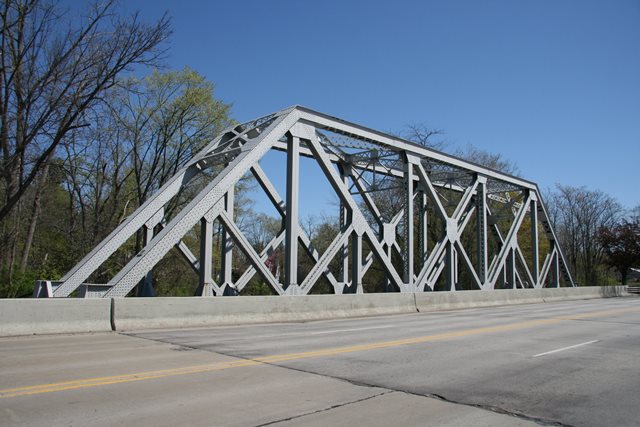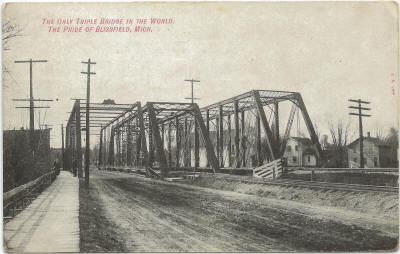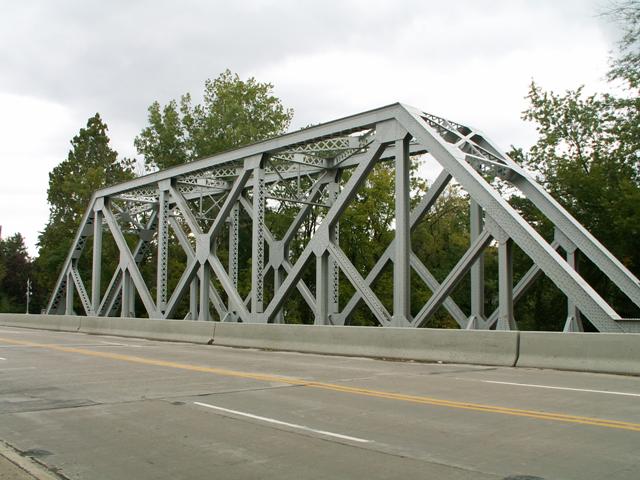We Recommend:
Bach Steel - Experts at historic truss bridge restoration.
BridgeHunter.com Phase 1 is released to the public! - Visit Now
Blissfield Railroad Bridge

Primary Photographer(s): Nathan Holth and Rick McOmber
Bridge Documented: 2006 and April 6, 2012
Blissfield: Lenawee County, Michigan: United States
1907 By Builder/Contractor: American Bridge Company of New York, New York
Not Available or Not Applicable
150.0 Feet (45.7 Meters)
150.0 Feet (45.7 Meters)
18 Feet (5.49 Meters)
1 Main Span(s)
Not Applicable

View Information About HSR Ratings
Bridge Documentation
This bridge is a good example of a railroad through truss. Its Baltimore truss configuration is uncommon in Michigan. The plaques, credit the American Bridge Company with building the bridge in 1907. This bridge sits right next to a public highway making it easy for people to view.
This bridge is similar to the Rockwood Railroad Bridge, both of which have the interesting star-like portal bracing design on them.
This bridge replaced an earlier metal truss railroad bridge at this location. During the time of the former bridge, two additional through truss bridges sat beside the bridge, one for an interurban line and the other for the highway. The below photo shows these three bridges, the highway to the left, the interurban in the center, and the railroad bridge to the right. The highway bridge was likely built by the Smith Bridge Company of Toledo, Ohio. The below postcard claims that at the time, the three bridges together were "the only triple bridge in the world" a claim of questionable validity.
Railroad bridges should present a solid example to road commissions and DOTs everywhere. Here is a beautiful truss bridge built in 1907 that stands today fulfilling its original purpose with no restrictions in like-new condition. If the railroad companies can do this, than why can't highway departments? The answer is they can. However, with funding assistance at the federal level provided mostly for replacement projects and little or none being provided to maintain bridges, highway agencies waste money by demolishing bridges and rebuilding them. In this sense, it is easier to not maintain a bridge and simply rebuild it, although it is much more costly. Despite this unrestrained government spending, they pretend they are penny-pinching and design bridges that are simple and ugly with no decorative attention. In contrast to all of this, railroad companies are a business, and it is in their best interest to make their dollar stretch as far as possible. As such, they tend to (but not always) actually maintain their bridges, and keep paint on them. Although in some instances, railroad companies are starting to replace bridges from this era, it has traditionally been far less common than with highways where historic truss bridges are replaced frequently.
The Blissfield Railroad Bridge is a perfect example of all of this. Sitting next to a flat, ugly slab-of-concrete highway bridge this railroad bridge soars above that ugly structure with beautiful latticed members organized in a Baltimore truss configuration. The fresh grey paint on this bridge makes the bridge look nice and neat, and is a nice change from the traditional black.
Above: Historical postcard showing previous railroad bridge and two other former bridges at this location.
Source: Donald Harrison, http://www.flickr.com/photos/upnorthmemories/5785958589/, CC BY-NC-ND 2.0
Above: This historical photo appears to show the start of the replacement project which ultimately concluded with the railroad bridge seen today on this webpage.
Above: Historical photo showing the current railroad bridge, but still showing the same two other former bridges.
This bridge is tagged with the following special condition(s): Unorganized Photos
![]()
Photo Galleries and Videos: Blissfield Railroad Bridge
Bridge Photo-Documentation
A collection of overview and detail photos. This photo gallery contains a combination of Original Size photos and Mobile Optimized photos in a touch-friendly popup viewer.Alternatively, Browse Without Using Viewer
![]()
Additional Unorganized Photos
Original / Full Size PhotosA supplemental collection of photos that are from additional visit(s) to the bridge and have not been organized or captioned. This gallery offers photos in the highest available resolution and file size in a touch-friendly popup viewer.
Alternatively, Browse Without Using Viewer
![]()
Additional Unorganized Photos
Mobile Optimized PhotosA supplemental collection of photos that are from additional visit(s) to the bridge and have not been organized or captioned. This gallery features data-friendly, fast-loading photos in a touch-friendly popup viewer.
Alternatively, Browse Without Using Viewer
![]()
Maps and Links: Blissfield Railroad Bridge
Coordinates (Latitude, Longitude):
Search For Additional Bridge Listings:
Bridgehunter.com: View listed bridges within 0.5 miles (0.8 kilometers) of this bridge.
Bridgehunter.com: View listed bridges within 10 miles (16 kilometers) of this bridge.
Additional Maps:
Google Streetview (If Available)
GeoHack (Additional Links and Coordinates)
Apple Maps (Via DuckDuckGo Search)
Apple Maps (Apple devices only)
Android: Open Location In Your Map or GPS App
Flickr Gallery (Find Nearby Photos)
Wikimedia Commons (Find Nearby Photos)
Directions Via Sygic For Android
Directions Via Sygic For iOS and Android Dolphin Browser
USGS National Map (United States Only)
Historical USGS Topo Maps (United States Only)
Historic Aerials (United States Only)
CalTopo Maps (United States Only)





